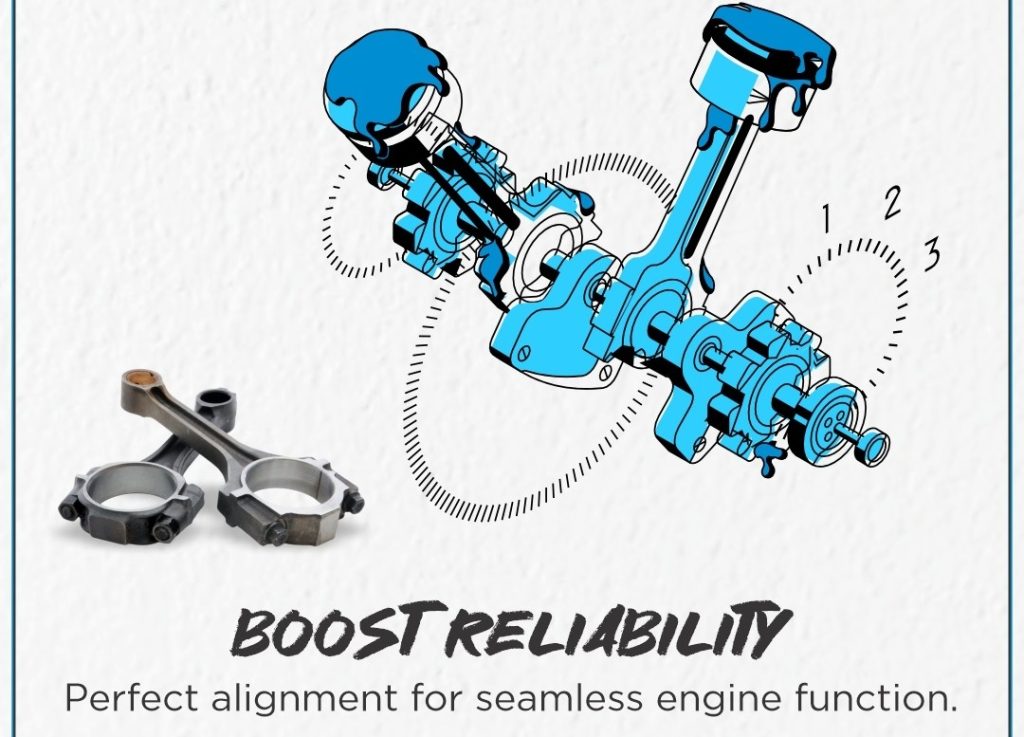Introduction
In any internal combustion engine, precision, alignment, and durability are crucial for seamless performance. Among the most critical components ensuring smooth engine function is the connecting rod. This vital link between the piston and crankshaft is responsible for transforming linear motion into rotational force, which drives the engine.
The image highlights the importance of perfect alignment in connecting rods, ensuring boosted reliability for engines in cars, motorcycles, trucks, and tractors. In this blog, we will explore the importance, functions, benefits, and material considerations of connecting rods, along with how Quintess International delivers high-quality components for superior engine performance.
What is a Connecting Rod?
A connecting rod (also known as a conrod) is a crucial engine component that connects the piston to the crankshaft. It plays a key role in converting the up-and-down motion of the piston into rotational motion, which powers the engine.
Each connecting rod consists of:
- Small End – Connects to the piston pin (also known as the wrist pin).
- Big End – Attaches to the crankshaft using a bearing shell and cap.
- Rod Body – The strong, elongated structure between the ends that transmits force.
How It Works
- During the intake stroke, the piston moves downward, pulling in the air-fuel mixture.
- During compression, the connecting rod helps the piston move up, compressing the mixture.
- In the power stroke, the air-fuel mixture ignites, pushing the piston down and transmitting force to the crankshaft via the connecting rod.
- Finally, in the exhaust stroke, the piston moves up again to expel gases, with the connecting rod maintaining smooth motion.
Why Perfect Alignment in Connecting Rods is Critical
Proper alignment of the connecting rod is essential for optimal performance and longevity. A misaligned or faulty connecting rod can cause serious engine issues, such as:
1. Increased Friction & Wear
A misaligned connecting rod leads to uneven force distribution, causing excessive wear on both the crankshaft and piston. This results in frictional losses, reducing efficiency and increasing heat build-up.
2. Engine Efficiency & Fuel Consumption
When the alignment is off, power transfer becomes inefficient, forcing the engine to work harder. This leads to:
- Higher fuel consumption
- Reduced power output
- Poor engine response
3. Vibrations & Engine Damage
A poorly aligned connecting rod causes imbalance in engine movement, leading to excess vibrations. This can result in:
- Bearing failures
- Piston slap noise
- Premature engine breakdown
4. Optimal Performance in High-Stress Environments
Engines in high-performance cars, commercial trucks, and agricultural machinery face extreme loads and RPMs. Well-aligned connecting rods ensure smooth operation, power efficiency, and durability, even under demanding conditions.
Types of Connecting Rods
Connecting rods vary based on the engine type, material, and manufacturing process. The most common types include:
1. Steel Connecting Rods
- Made from forged steel or billet steel
- High strength & durability
- Commonly used in commercial vehicles and high-performance cars
2. Aluminium Connecting Rods
- Lightweight & offers excellent high-RPM performance
- Used in racing engines and high-speed motorcycles
3. Titanium Connecting Rods
- Extremely strong yet lightweight
- Provides high strength-to-weight ratio
- Used in motorsports and aerospace applications
4. Cast Iron Connecting Rods
- Cost-effective but less durable
- Common in low-power engines
How High-Quality Connecting Rods Enhance Engine Reliability
1. Strength & Durability
Premium connecting rods, such as those from Quintess International, are designed for heavy-duty use and can withstand high stress, heat, and pressure without deformation. This exceptional resilience is achieved through advanced engineering techniques and the use of high-quality materials, ensuring that these components can maintain their structural integrity even in the most demanding environments. As a result, they not only enhance the performance of the engine but also contribute to its longevity, reducing the need for frequent repairs or replacements.
Moreover, the ability to endure extreme conditions allows these connecting rods to perform reliably under various driving scenarios, whether it’s high-speed racing or heavy towing. Ultimately, this strength and durability translate to greater confidence for vehicle owners, knowing that their engine is equipped with components that prioritize durability and reliability
2. Precision Engineering for Alignment
Precision machining ensures that each rod fits perfectly within the engine, reducing the risk of mechanical failures and misalignment issues. This meticulous attention to detail not only enhances the overall performance of the engine but also contributes to its longevity. By maintaining tight tolerances during the manufacturing process, engineers can create components that work seamlessly together, minimizing wear and tear over time.
Furthermore, the precision achieved in machining allows for better fuel efficiency and reduced emissions, as the engine operates more smoothly and effectively. Ultimately, the investment in precision engineering translates to a more reliable and efficient engine, providing peace of mind for both manufacturers and end-users.
3. Weight Optimization for Performance
Lightweight connecting rods help improve engine response and fuel efficiency, particularly in performance vehicles. By reducing the overall mass of the engine components, these rods allow for quicker acceleration and more agile handling. This is especially important in high-performance applications where every millisecond counts.
Furthermore, the decreased weight contributes to less strain on the engine, enabling it to operate more efficiently and sustainably over time. As a result, drivers can enjoy not only enhanced performance but also better fuel economy, making lightweight connecting rods a valuable upgrade for enthusiasts seeking to maximize their vehicle’s potential.
4. Compatibility with Different Vehicles
Whether for cars, motorcycles, trucks, or tractors, the right connecting rod ensures maximum efficiency and power output. This is crucial because each vehicle type has its own unique engine specifications and performance requirements. For instance, a connecting rod designed for a high-performance sports car will differ significantly from one intended for a heavy-duty truck.
Moreover, the material composition and design of the connecting rod must align with the vehicle’s intended use. In racing applications, lightweight materials are often preferred to enhance speed and agility, while heavy-duty vehicles may require more robust components to withstand greater stress and load
Quintess International: Delivering Engine Excellence
Quintess International is a leading supplier of precision-engineered connecting rods for various industries. Their expertise in high-quality materials, advanced manufacturing, and strict quality control ensures superior performance and reliability.
Why Choose Quintess International?
✅ High-Quality Materials – Manufactured using forged steel, aluminium, and advanced alloys.
✅ Precision Machining – Ensures perfect alignment and fit.
✅ Wide Compatibility – Suitable for automotive, industrial, and heavy-duty engines.
✅ Industry Expertise – Years of experience in engine component manufacturing.
For top-tier connecting rods and other engine components, visit www.quintessinternational.in or contact +91 6353213071 to learn more.



